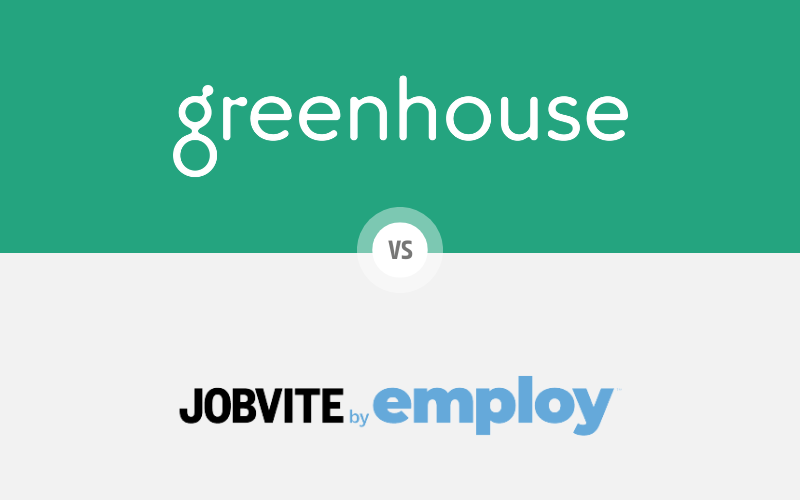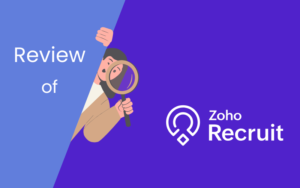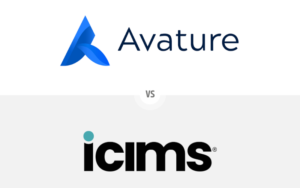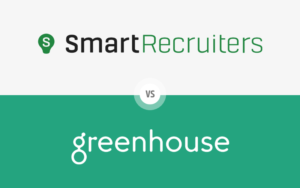When evaluating Applicant Tracking System (ATS), the comparison between Greenhouse vs Jobvite is essential for organizations looking to enhance their recruitment processes. Both platforms offer a range of features designed to streamline hiring, improve candidate experience, and provide valuable insights through reporting and analytics. However, understanding the unique strengths and weaknesses of each system is crucial for making an informed decision that aligns with your organization’s specific needs. In this blog post, we will explore various aspects of both Greenhouse and Jobvite, including user interface, core ATS functions, candidate experience, customer support, pricing, and more, to help you determine which platform is the best fit for your recruitment strategy.
Table of Contents
User Interface and User Experience
When comparing Greenhouse vs Jobvite in terms of user interface (UI) and user experience (UX), it’s crucial to understand how each platform caters to the needs of recruiters, hiring managers, and candidates. Both Applicant Tracking Systems (ATS) aim to streamline the recruitment process, but they approach this goal with distinct interfaces and features that can significantly impact user satisfaction and efficiency.
Greenhouse User Interface and User Experience
Greenhouse has gained a reputation for its clean, intuitive interface designed to accommodate businesses of all sizes. The platform’s focus on simplicity and user-friendliness is evident in its well-organized layout and thoughtful design choices.
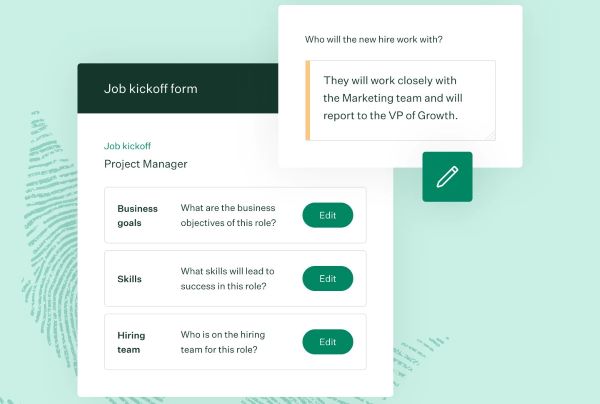
Key Features of Greenhouse UI/UX:
- Intuitive Dashboard: Greenhouse’s dashboard provides a clear overview of the recruitment pipeline, with easy access to key metrics and pending tasks. The layout is designed to minimize cognitive load, allowing recruiters to quickly grasp important information at a glance.
- Customizable Workflows: Users can tailor the recruitment process to match their organization’s unique needs. This flexibility extends to creating custom interview kits, scorecards, and evaluation forms, ensuring that the hiring process aligns perfectly with company standards.
- Mobile Responsiveness: Greenhouse offers a fully responsive design that adapts seamlessly to various screen sizes. The mobile app for iOS and Android devices allows hiring managers to review candidates, provide feedback, and manage tasks on-the-go, significantly enhancing productivity.
- Candidate-Centric Application Process: The platform emphasizes a streamlined application experience. Candidates can easily navigate through job listings, submit applications, and track their progress. The option to apply with LinkedIn or upload resumes from cloud storage services reduces friction in the application process.
- Visual Job Boards: Greenhouse’s visual job boards provide an at-a-glance view of all open positions, making it easy for recruiters to manage multiple openings simultaneously.
- Integrated Scheduling: The built-in scheduling tool simplifies the process of coordinating interviews, reducing back-and-forth communications and saving time for both recruiters and candidates.
While Greenhouse is praised for its user-friendly interface, some users note that accessing more advanced features may require additional training. However, the platform offers comprehensive onboarding resources and tutorials to help users quickly become proficient.
Jobvite User Interface and User Experience
Jobvite offers a robust and feature-rich interface, catering to organizations with diverse and complex hiring needs. Known for its extensive functionality, Jobvite provides a comprehensive platform that can handle a wide variety of recruitment processes.
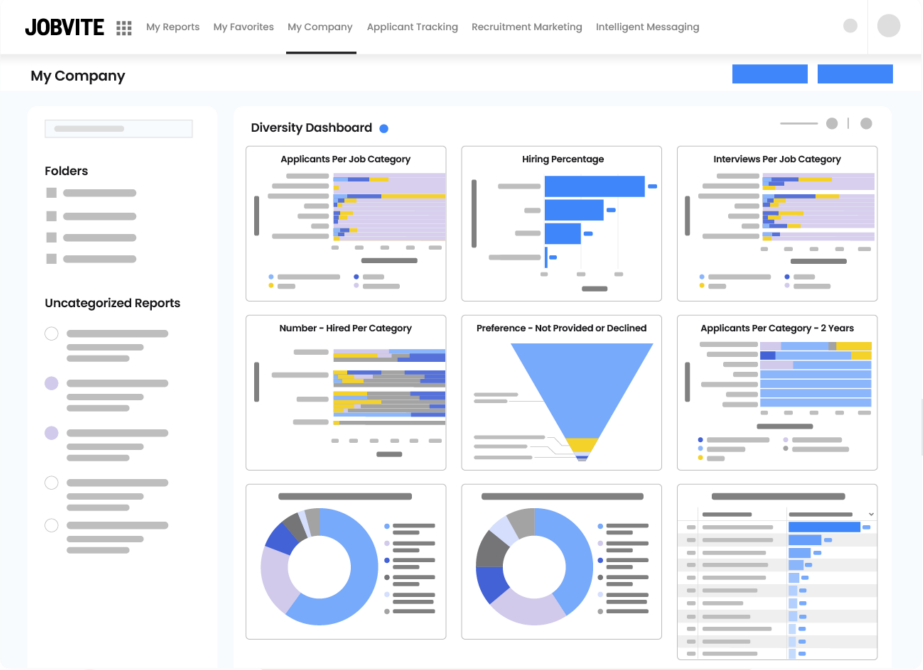
Key Features of Jobvite UI/UX:
- Customizable Dashboard: Jobvite’s dashboard is highly configurable, allowing users to create personalized views that display the most relevant information for their role. This customization extends to workflows, enabling organizations to tailor the recruitment process to their specific needs.
- Advanced Search and Filtering: The platform offers powerful search capabilities, allowing recruiters to quickly find candidates based on various criteria. The ability to save and share custom searches enhances collaboration among team members.
- Comprehensive Candidate Profiles: Jobvite creates detailed candidate profiles that include all interactions, notes, and evaluations in one place. This centralized view helps recruiters make informed decisions and provides a holistic picture of each applicant.
- Mobile Optimization: Jobvite provides mobile-optimized career sites and a mobile app for recruiters. This enables on-the-go management of recruitment tasks and ensures that candidates can easily apply for positions using their mobile devices.
- Social Recruiting Tools: The platform integrates robust social media functionality, allowing recruiters to leverage social networks for candidate sourcing and employer branding.
- Automated Communication: Jobvite’s communication tools include automated email and text messaging features, helping to keep candidates informed throughout the hiring process.
- Analytics and Reporting: The platform offers advanced analytics and reporting capabilities, providing insights into recruitment performance and helping organizations make data-driven decisions.
While Jobvite’s extensive feature set is appreciated by many users, some reviewers mention that the initial setup and learning curve can be steeper compared to simpler ATS solutions. Organizations may need to invest more time in training and configuration to fully leverage the platform’s capabilities.
Comparison and Conclusion
Choosing between Greenhouse vs Jobvite for user interface and user experience requires a thorough understanding of your organization’s recruitment needs, technical resources, and long-term hiring strategy.
Greenhouse excels in providing a clean, intuitive interface that prioritizes ease of use and efficiency. Its design philosophy focuses on simplifying complex recruitment processes, making it particularly appealing to organizations that value quick adoption and straightforward workflows. The platform’s mobile responsiveness and streamlined candidate application process are notable strengths, making it an excellent choice for teams looking to enhance their recruitment agility and improve the candidate experience.
Jobvite, on the other hand, offers a more feature-rich interface that can be extensively customized to fit specific recruitment workflows. This flexibility makes it a strong contender for organizations with complex hiring processes or those who prioritize a highly tailored recruitment experience. The comprehensive dashboard, advanced search capabilities, and robust social recruiting tools are particularly beneficial for teams that require detailed tracking, reporting, and multi-channel sourcing strategies.
In terms of user satisfaction, both platforms perform well, with Greenhouse often scoring slightly higher in user reviews for overall ease of use. This edge reflects Greenhouse’s focus on user-friendliness and intuitive design. However, Jobvite’s strengths lie in its extensive features and customization capabilities, which can be particularly valuable for larger organizations or those with specialized recruitment needs.

In summary:
- Greenhouse is best suited for:
- Organizations seeking a user-friendly, efficient system with strong mobile capabilities
- Teams that value simplicity and quick adoption
- Companies looking to enhance their recruitment efforts with minimal training required
- Businesses that prioritize a smooth candidate experience
- Jobvite is ideal for:
- Companies needing detailed control and extensive customization in their recruitment process
- Organizations with complex hiring needs and multiple recruitment channels
- Teams that require advanced analytics and reporting capabilities
- Businesses looking for robust social recruiting and employer branding tools
Ultimately, the choice between Greenhouse vs Jobvite depends on your organization’s size, the complexity of your recruitment needs, and your preference for out-of-the-box usability versus extensive customization. Both platforms offer strong UI/UX features but cater to slightly different priorities within the recruitment ecosystem.
When making your decision, consider factors such as:
- The size and structure of your hiring team
- The volume and diversity of your hiring needs
- Your organization’s technical resources and capacity for platform configuration
- The importance of social recruiting and employer branding in your strategy
- Your requirements for analytics and data-driven decision making
By carefully evaluating these factors against the strengths of each platform, you can select the ATS that will best support your recruitment strategy, enhance productivity, and meet your specific requirements. Remember that the right choice will not only improve your team’s efficiency but also contribute to a better candidate experience, ultimately helping you attract and retain top talent in today’s competitive job market.
Core ATS Functions
When evaluating Greenhouse vs Jobvite, it’s essential to examine their core Applicant Tracking System (ATS) functions. These fundamental features form the backbone of any recruitment software, enabling organizations to efficiently manage their hiring processes. Both platforms offer robust core functionalities, but they differ in their approach and execution.
Greenhouse Core ATS Functions
Greenhouse has built a reputation for providing a comprehensive set of core ATS functions that cater to various organizational needs.
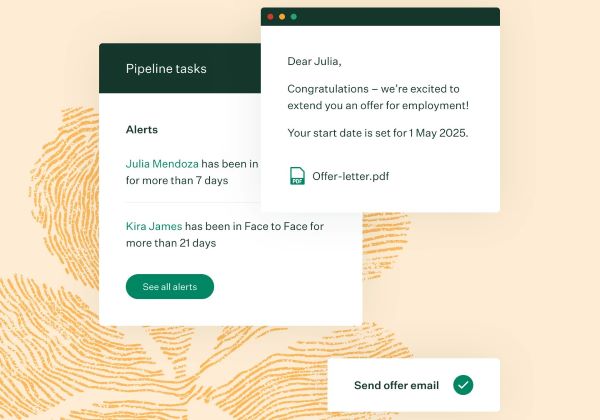
Key Features of Greenhouse Core ATS Functions:
- Job Posting and Distribution: Greenhouse offers seamless integration with multiple job boards and social media platforms. Users can create and distribute job postings across various channels with just a few clicks. The platform also provides tools to optimize job descriptions for better visibility and candidate attraction.
- Resume Parsing and Screening: Greenhouse’s advanced parsing technology accurately extracts relevant information from resumes, creating standardized candidate profiles. The system’s intelligent screening capabilities allow recruiters to set specific criteria, automatically flagging candidates who meet the requirements.
- Candidate Sourcing Tools: The platform includes a suite of sourcing tools, including a Chrome extension for easy candidate addition from various websites. Greenhouse also offers integrations with popular sourcing platforms, enhancing recruiters’ ability to find and engage potential candidates.
- Applicant Tracking and Management: Greenhouse provides a centralized database for all candidate information, allowing recruiters to track applicants throughout the hiring process. The system offers customizable pipelines and stages, ensuring that each candidate moves through the process efficiently.
- Interview Management: The platform excels in interview scheduling and feedback collection. It offers a user-friendly interface for coordinating complex interview schedules and provides structured scorecards for consistent candidate evaluation.
Greenhouse’s core ATS functions are designed with user experience in mind, making it easy for both seasoned recruiters and hiring managers to navigate the system effectively.
Jobvite Core ATS Functions
Jobvite offers a robust set of core ATS functions, with a focus on automation and data-driven recruitment.
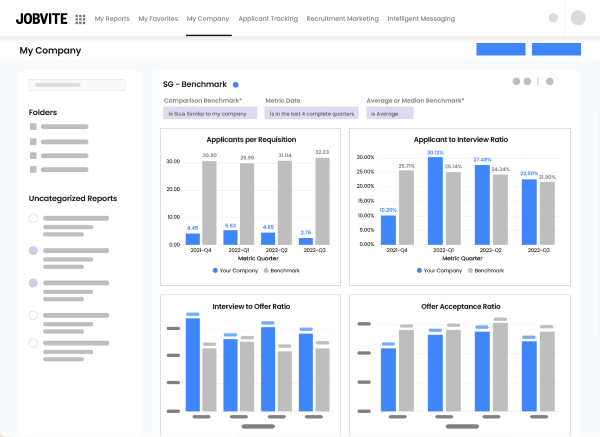
Key Features of Jobvite Core ATS Functions:
- Job Requisition and Approval: Jobvite provides a streamlined process for creating and approving job requisitions. The system allows for multiple approval levels and offers customizable templates to ensure consistency across job postings.
- Candidate Sourcing and CRM: The platform includes a built-in Candidate Relationship Management (CRM) system, allowing recruiters to nurture talent pools and engage with passive candidates. Jobvite’s sourcing tools integrate with various social media platforms and professional networks.
- Resume Parsing and Screening: Jobvite employs advanced parsing technology to extract and categorize information from resumes. The platform’s AI-powered screening tools help recruiters quickly identify top candidates based on predefined criteria.
- Applicant Workflow Management: The system offers highly customizable workflows, allowing organizations to tailor the recruitment process to their specific needs. Jobvite’s drag-and-drop interface makes it easy to move candidates through different stages of the hiring process.
- Reporting and Analytics: Jobvite provides comprehensive reporting tools, offering insights into key recruitment metrics. The platform’s analytics capabilities help organizations make data-driven decisions to optimize their hiring processes.
Jobvite’s core ATS functions are designed to handle high-volume recruiting while providing the flexibility needed for complex hiring scenarios.
Comparison and Conclusion
When comparing Greenhouse vs Jobvite in terms of core ATS functions, both platforms offer strong capabilities that can significantly streamline the recruitment process. However, they each have their unique strengths that may appeal to different types of organizations.
Greenhouse stands out for its user-friendly interface and intuitive design, making it easier for teams to adopt and use effectively. Its interview management and candidate evaluation tools are particularly robust, offering structured ways to assess and compare candidates. The platform’s focus on creating a smooth experience for both recruiters and candidates is evident in its core functions.
Jobvite, on the other hand, excels in its automation capabilities and data-driven approach. The platform’s CRM functionality and advanced analytics tools make it a strong choice for organizations that prioritize long-term talent nurturing and strategic workforce planning. Jobvite’s highly customizable workflows also make it suitable for companies with complex or unique hiring processes.
In summary:
- Greenhouse is ideal for:
- Organizations that value ease of use and quick adoption
- Companies looking for strong interview management and candidate evaluation tools
- Teams that prioritize a positive candidate experience
- Jobvite is well-suited for:
- Organizations with high-volume recruiting needs
- Companies that require extensive customization in their hiring workflows
- Teams that focus on data-driven recruitment strategies and long-term talent nurturing
When choosing between Greenhouse vs Jobvite for core ATS functions, consider your organization’s specific needs, such as the volume of hiring, the complexity of your recruitment processes, and the level of customization required. Both platforms offer comprehensive core ATS functions, but their different approaches may align better with different organizational priorities.
Ultimately, the right choice will depend on how well the platform’s core functions align with your recruitment strategy and operational needs. By carefully evaluating these factors, you can select the ATS that will best support your organization’s hiring goals and contribute to building a strong, talented workforce.
Applicant Management
Effective applicant management is crucial for streamlining the hiring process and ensuring a positive candidate experience. When comparing Greenhouse vs Jobvite, it’s important to examine how each platform handles applicant management, including candidate pipeline visualization, communication tools, and interview scheduling.
Greenhouse Applicant Management
Greenhouse offers a comprehensive approach to applicant management, focusing on organization and efficiency.
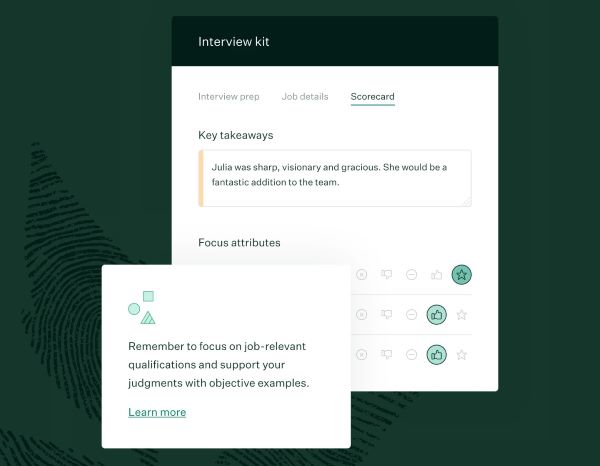
Key Features of Greenhouse Applicant Management:
- Candidate Pipeline Visualization: Greenhouse provides a clear, visual representation of the candidate pipeline. Users can easily track applicants through various stages of the hiring process, with customizable pipelines that reflect each organization’s unique workflow.
- Communication Tools: The platform offers robust communication features, including email integration and templated responses. Recruiters can send personalized messages directly from the system, maintaining a consistent and professional communication flow with candidates.
- Interview Scheduling: Greenhouse excels in interview coordination with its built-in scheduling tool. It integrates with popular calendar applications and allows for complex interview scheduling, including panel interviews and multi-day assessments.
- Collaborative Hiring: The system promotes team collaboration with features like shared notes, @mentions, and centralized feedback collection. This ensures all stakeholders are aligned throughout the hiring process.
- Candidate Profiles: Greenhouse creates comprehensive candidate profiles that include all interactions, notes, and evaluations in one place, providing a holistic view of each applicant.
Greenhouse’s applicant management features are designed to be intuitive and user-friendly, making it easier for hiring teams to stay organized and efficient.
Jobvite Applicant Management
Jobvite approaches applicant management with a focus on automation and data-driven decision-making.
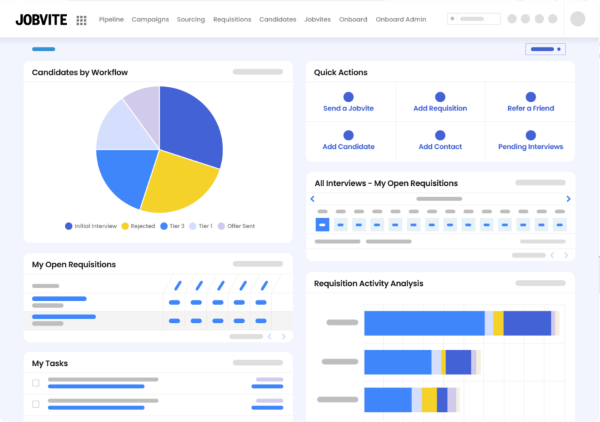
Key Features of Jobvite Applicant Management:
- Dynamic Candidate Pipeline: Jobvite offers a flexible candidate pipeline that can be customized to fit various hiring processes. The system provides real-time updates and allows for easy movement of candidates between stages.
- Multi-Channel Communication: The platform includes advanced communication tools, supporting email, SMS, and social media interactions. Jobvite’s texting capabilities are particularly noteworthy, allowing for quick and efficient candidate engagement.
- AI-Powered Scheduling: Jobvite leverages artificial intelligence to streamline the interview scheduling process. The system can automatically suggest optimal interview times based on participants’ availability.
- Candidate Relationship Management (CRM): Jobvite’s CRM functionality allows recruiters to nurture relationships with passive candidates and build talent pools for future opportunities.
- Analytics and Reporting: The platform provides detailed analytics on applicant management, offering insights into pipeline efficiency, time-to-hire, and other key metrics.
Jobvite’s applicant management features are designed to handle high-volume recruiting while providing detailed insights to optimize the hiring process.
Comparison and Conclusion
When comparing Greenhouse vs Jobvite in terms of applicant management, both platforms offer strong capabilities, but with different emphases that may suit different organizational needs.
Greenhouse stands out for its user-friendly interface and collaborative features. Its visual pipeline, intuitive scheduling tools, and emphasis on team collaboration make it an excellent choice for organizations that prioritize a streamlined, transparent hiring process. The platform’s approach to applicant management is particularly well-suited for companies that value a personalized touch in their recruitment efforts.
Jobvite, on the other hand, excels in its automation capabilities and data-driven approach to applicant management. Its AI-powered scheduling, advanced communication tools, and robust analytics make it a strong contender for organizations dealing with high-volume recruiting or those looking to optimize their hiring processes through data analysis. The platform’s CRM functionality also gives it an edge for companies focused on long-term talent acquisition strategies.
In summary:
- Greenhouse is ideal for:
- Organizations that value ease of use and visual pipeline management
- Companies looking for strong collaborative hiring features
- Teams that prioritize a personalized approach to candidate communication
- Jobvite is well-suited for:
- Organizations with high-volume recruiting needs
- Companies that require advanced automation in their applicant management
- Teams that focus on data-driven recruitment strategies and long-term talent nurturing
When choosing between Greenhouse vs Jobvite for applicant management, consider your organization’s specific needs, such as the volume of applications you typically handle, the complexity of your hiring processes, and the level of automation and analytics you require. Both platforms offer comprehensive applicant management features, but their different approaches may align better with different organizational priorities.
Ultimately, the right choice will depend on how well the platform’s applicant management capabilities align with your recruitment strategy and operational needs. By carefully evaluating these factors, you can select the ATS that will best support your organization’s hiring goals and contribute to building a strong, talented workforce while ensuring a positive candidate experience.
Recruitment Marketing
When comparing Greenhouse vs Jobvite, it’s crucial to examine their recruitment marketing capabilities. Effective recruitment marketing helps organizations attract top talent by leveraging marketing strategies to promote their employer brand and open positions.
Greenhouse Recruitment Marketing
Greenhouse offers a comprehensive suite of recruitment marketing tools designed to enhance an organization’s ability to attract and engage potential candidates.
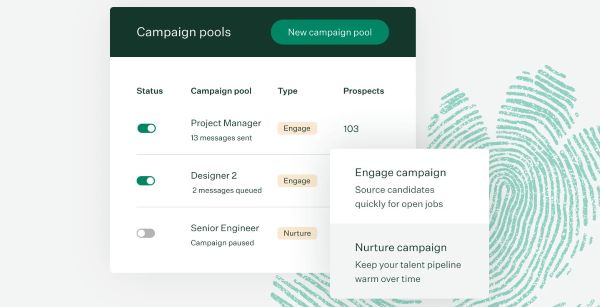
Key Features of Greenhouse Recruitment Marketing:
- Career Site Builder: Greenhouse provides a user-friendly career site builder that allows companies to create branded, mobile-responsive career pages. These pages can be customized to reflect the organization’s culture and values, helping to attract candidates who align with the company’s mission.
- Social Media Integration: The platform offers seamless integration with various social media channels, enabling recruiters to share job postings and company content across multiple platforms. This feature helps expand the reach of recruitment efforts and engage with passive candidates.
- Employee Referral Programs: Greenhouse includes tools to create and manage employee referral programs, leveraging the networks of current employees to find qualified candidates. The system makes it easy for employees to share job openings and track the status of their referrals.
- Job Board Distribution: The platform automates the process of distributing job postings to multiple job boards, increasing visibility and reaching a wider pool of potential candidates.
- Candidate Relationship Management (CRM): Greenhouse’s CRM functionality allows recruiters to nurture relationships with potential candidates over time, keeping them engaged with the company even when there aren’t immediate job openings.
Greenhouse’s recruitment marketing features focus on creating a cohesive employer brand presence across various channels, making it easier for organizations to attract and engage with top talent.
Jobvite Recruitment Marketing
Jobvite approaches recruitment marketing with a strong emphasis on data-driven strategies and automation.
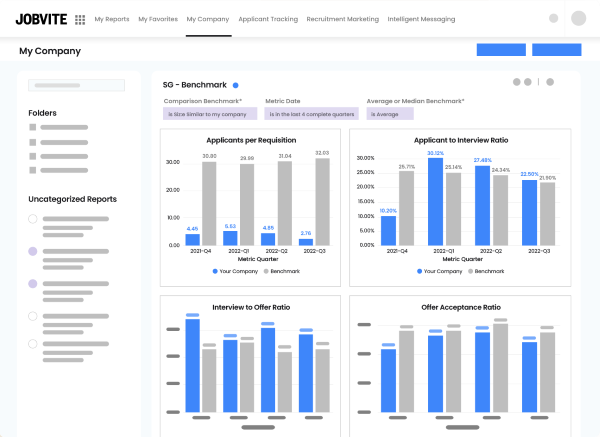
Key Features of Jobvite Recruitment Marketing:
- AI-Powered Career Site: Jobvite offers an AI-driven career site that personalizes the candidate experience, recommending relevant job openings based on a visitor’s profile and behavior.
- Social Recruiting Tools: The platform provides advanced social recruiting capabilities, including the ability to create and manage social media campaigns directly from the ATS. Jobvite’s social job distribution feature allows for easy sharing of job openings across various social networks.
- Employee Advocacy: Jobvite includes tools to turn employees into brand ambassadors, making it easy for them to share job openings and company content on their personal social media accounts.
- Targeted Campaigns: The system allows for the creation of targeted email and SMS campaigns to engage with specific candidate segments, nurturing relationships with potential hires over time.
- Analytics and Reporting: Jobvite provides detailed analytics on recruitment marketing efforts, allowing organizations to measure the effectiveness of their campaigns and optimize their strategies accordingly.
Jobvite’s recruitment marketing features are designed to leverage data and automation to create highly targeted and effective recruitment campaigns.
Comparison and Conclusion
When comparing Greenhouse vs Jobvite in terms of recruitment marketing, both platforms offer strong capabilities, but with different areas of focus that may suit different organizational needs.
Greenhouse excels in providing a user-friendly interface for creating branded career sites and managing employee referral programs. Its approach to recruitment marketing emphasizes creating a cohesive employer brand presence across various channels, making it an excellent choice for organizations looking to build a strong employer brand and leverage their employees’ networks.
Jobvite, on the other hand, stands out with its AI-powered career site and advanced social recruiting tools. Its data-driven approach to recruitment marketing, coupled with robust analytics and reporting capabilities, makes it a strong contender for organizations looking to implement highly targeted and measurable recruitment marketing campaigns.
In summary:
- Greenhouse is ideal for:
- Organizations focused on building a strong employer brand
- Companies looking to leverage employee referrals effectively
- Teams that value ease of use in creating and managing career sites
- Jobvite is well-suited for:
- Organizations that prioritize data-driven recruitment marketing strategies
- Companies looking to implement advanced social recruiting campaigns
- Teams that require detailed analytics and reporting on their recruitment marketing efforts
When choosing between Greenhouse vs Jobvite for recruitment marketing, consider your organization’s specific needs, such as the importance of employer branding, the level of social media engagement you require, and the depth of analytics you need to optimize your recruitment marketing efforts. Both platforms offer comprehensive recruitment marketing features, but their different approaches may align better with different organizational priorities.
Ultimately, the right choice will depend on how well the platform’s recruitment marketing capabilities align with your overall talent acquisition strategy. By carefully evaluating these factors, you can select the ATS that will best support your organization’s efforts to attract and engage top talent in an increasingly competitive job market.
Collaboration Tools
In the comparison of Greenhouse vs Jobvite, collaboration tools play a crucial role in facilitating efficient teamwork throughout the hiring process. These features enable hiring teams to communicate effectively, share feedback, and make informed decisions collectively.
Greenhouse Collaboration Tools
Greenhouse offers a range of collaboration features designed to streamline communication and decision-making within hiring teams.
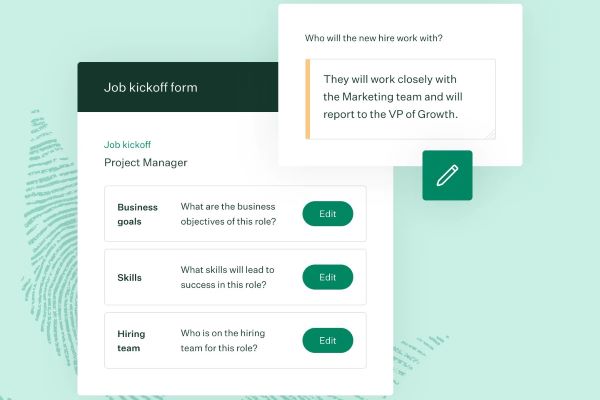
Key Features of Greenhouse Collaboration Tools:
- Team Feedback and Evaluation: Greenhouse provides structured scorecards and evaluation forms that allow interviewers to provide consistent, objective feedback on candidates. These scorecards can be customized to align with specific job requirements and company values.
- Internal Messaging and Notes: The platform includes an internal messaging system that allows team members to communicate about candidates directly within the ATS. Users can leave notes on candidate profiles, tag colleagues, and engage in threaded discussions.
- Collaborative Hiring Plans: Greenhouse enables teams to create and share hiring plans, ensuring all stakeholders are aligned on the recruitment strategy for each role.
- Interview Kits: The system offers customizable interview kits that provide interviewers with structured questions and evaluation criteria, promoting consistency across the hiring process.
- Mobile Collaboration: Greenhouse’s mobile app allows team members to provide feedback and communicate on-the-go, ensuring timely input from all stakeholders.
Greenhouse’s collaboration tools focus on promoting transparency and consistency throughout the hiring process, making it easier for teams to work together effectively.
Jobvite Collaboration Tools
Jobvite approaches collaboration with a focus on real-time communication and data-driven decision-making.
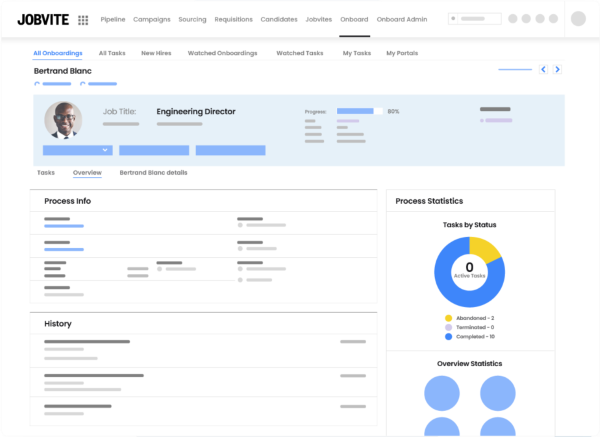
Key Features of Jobvite Collaboration Tools:
- Team Feedback and Evaluation: Jobvite offers customizable evaluation forms and rating scales that allow interviewers to provide structured feedback on candidates. The platform also includes features for comparing candidate evaluations side-by-side.
- Internal Messaging and Notes: The system provides in-app messaging capabilities, allowing team members to communicate about candidates and hiring decisions. Users can leave notes, @mention colleagues, and share updates in real-time.
- Collaborative Hiring Workflows: Jobvite allows teams to create and manage custom hiring workflows, ensuring all team members understand their roles and responsibilities in the hiring process.
- Interview Guides: The platform offers interview guides that can be shared among team members, providing consistent question sets and evaluation criteria for each role.
- Analytics and Reporting: Jobvite’s collaboration tools are integrated with its analytics features, allowing teams to track and measure the effectiveness of their collaborative efforts in the hiring process.
Jobvite’s collaboration features emphasize real-time communication and data-driven insights to support effective teamwork in recruitment.
Comparison and Conclusion
When comparing Greenhouse vs Jobvite in terms of collaboration tools, both platforms offer robust features to support team-based hiring processes, but with different strengths that may appeal to different organizational needs.
Greenhouse stands out for its user-friendly interface and structured approach to collaboration. Its customizable scorecards, interview kits, and collaborative hiring plans make it particularly effective for organizations that prioritize consistency and transparency in their hiring processes. The platform’s mobile app also ensures that team members can stay connected and provide input regardless of their location.
Jobvite, on the other hand, excels in its integration of collaboration tools with analytics and reporting features. This approach is particularly beneficial for organizations that value data-driven decision-making in their hiring processes. Jobvite’s real-time communication features and customizable workflows also make it a strong choice for teams that require flexibility and rapid information sharing.
In summary:
- Greenhouse is ideal for:
- Organizations that value structured, consistent collaboration processes
- Teams that prioritize mobile accessibility in their collaboration tools
- Companies looking for user-friendly, intuitive collaboration features
- Jobvite is well-suited for:
- Organizations that emphasize data-driven collaboration in hiring
- Teams that require highly customizable hiring workflows
- Companies looking for strong integration between collaboration and analytics features
When choosing between Greenhouse vs Jobvite for collaboration tools, consider your organization’s specific needs, such as the level of structure required in your hiring process, the importance of mobile accessibility, and the degree to which you rely on data analytics in your decision-making. Both platforms offer comprehensive collaboration features, but their different approaches may align better with different team dynamics and organizational cultures.
Ultimately, the right choice will depend on how well the platform’s collaboration tools align with your team’s working style and your overall recruitment strategy. By carefully evaluating these factors, you can select the ATS that will best support your organization’s collaborative hiring efforts, leading to more effective team-based recruitment and better hiring outcomes.
Onboarding Integration
When comparing Greenhouse vs Jobvite, it’s essential to consider their onboarding integration capabilities. Effective onboarding integration ensures a smooth transition from candidate to employee, streamlining the process and improving new hire experiences.
Greenhouse Onboarding Integration
Greenhouse offers a comprehensive onboarding solution that integrates seamlessly with its ATS, providing a cohesive experience from recruitment to new hire orientation.
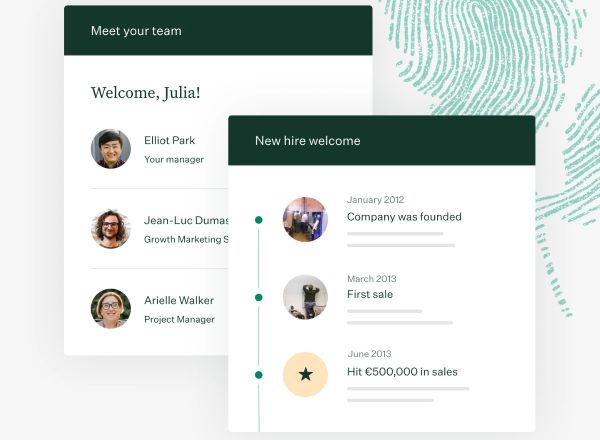
Key Features of Greenhouse Onboarding Integration:
- Offer Letter Management: Greenhouse provides tools for creating, sending, and tracking offer letters directly within the platform. This feature includes customizable templates and e-signature capabilities, streamlining the offer process.
- New Hire Paperwork Automation: The system automates the distribution and collection of new hire paperwork, including tax forms, company policies, and other essential documents. This reduces manual work and ensures compliance.
- Onboarding Task Management: Greenhouse allows HR teams to create customizable onboarding plans with assigned tasks for new hires, their managers, and HR personnel. This ensures all necessary steps are completed in a timely manner.
- Integration with HRIS: Greenhouse offers integrations with various Human Resource Information Systems (HRIS), allowing for seamless data transfer between recruitment and employee management systems.
- New Hire Portal: The platform provides a dedicated portal for new hires, giving them access to important information, tasks, and resources before their start date.
Greenhouse’s onboarding integration focuses on creating a smooth, automated transition from candidate to employee, with an emphasis on user-friendly interfaces for both HR teams and new hires.
Jobvite Onboarding Integration
Jobvite approaches onboarding integration with a focus on automation and data consistency across the employee lifecycle.
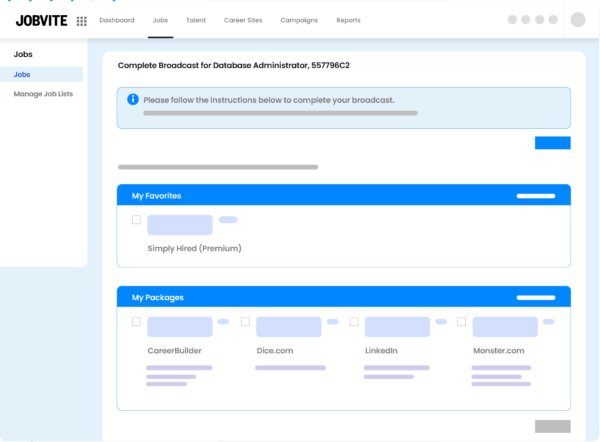
Key Features of Jobvite Onboarding Integration:
- Offer Management: Jobvite includes tools for creating and managing offer letters, with customizable templates and approval workflows. The system supports e-signatures and offer tracking.
- New Hire Paperwork Digitization: The platform digitizes and automates the distribution of new hire paperwork, including I-9 forms, W-4 forms, and company-specific documents.
- Onboarding Workflows: Jobvite allows for the creation of customizable onboarding workflows that can be tailored to different roles or departments, ensuring consistency in the onboarding process.
- HRIS Integration: The system offers robust integration capabilities with various HRIS platforms, facilitating smooth data transfer and reducing duplicate data entry.
- Employee Self-Service Portal: Jobvite provides a self-service portal for new hires, allowing them to complete necessary tasks and access important information before their start date.
Jobvite’s onboarding integration emphasizes automation and data consistency, aiming to create a seamless transition from candidate to employee while minimizing manual work for HR teams.
Comparison and Conclusion
When comparing Greenhouse vs Jobvite in terms of onboarding integration, both platforms offer strong features to support the transition from recruitment to employment, but with different areas of focus that may suit different organizational needs.
Greenhouse excels in providing a user-friendly, intuitive onboarding experience for both HR teams and new hires. Its customizable onboarding plans and dedicated new hire portal make it particularly effective for organizations that prioritize a personalized and engaging onboarding experience. The platform’s seamless integration between ATS and onboarding functions ensures a smooth transition from candidate to employee.
Jobvite, on the other hand, stands out with its focus on automation and data consistency across the employee lifecycle. Its customizable workflows and robust HRIS integration capabilities make it a strong choice for organizations looking to streamline their onboarding processes and maintain data integrity across multiple HR systems.
In summary:
- Greenhouse is ideal for:
- Organizations that prioritize a user-friendly, personalized onboarding experience
- Companies looking for highly customizable onboarding plans
- Teams that value a seamless integration between recruitment and onboarding processes
- Jobvite is well-suited for:
- Organizations that emphasize automation in their onboarding processes
- Companies requiring robust HRIS integration capabilities
- Teams looking to maintain data consistency across the entire employee lifecycle
When choosing between Greenhouse vs Jobvite for onboarding integration, consider your organization’s specific needs, such as the level of customization required in your onboarding process, the importance of automation, and the extent of integration needed with other HR systems. Both platforms offer comprehensive onboarding integration features, but their different approaches may align better with different organizational priorities and existing HR tech stacks.
Ultimately, the right choice will depend on how well the platform’s onboarding integration capabilities align with your overall HR strategy and the specific needs of your new hires. By carefully evaluating these factors, you can select the ATS that will best support your organization’s efforts to create a smooth, efficient, and engaging onboarding experience, setting the stage for long-term employee success and retention.
Reporting and Analytics
In the comparison of Greenhouse vs Jobvite, reporting and analytics capabilities play a crucial role in enabling data-driven decision-making throughout the recruitment process. Both platforms offer robust features in this area, but with different strengths and approaches.
Greenhouse Reporting and Analytics
Greenhouse provides a comprehensive suite of reporting and analytics tools designed to give users deep insights into their recruitment processes.
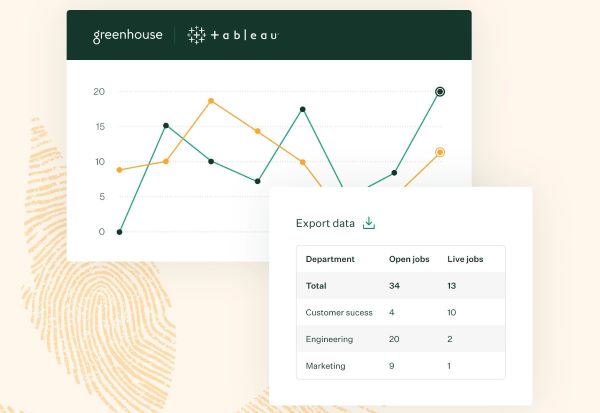
Key Features of Greenhouse Reporting and Analytics:
- Recruitment Metrics and KPIs: Greenhouse offers a wide range of pre-built reports covering key recruitment metrics such as time-to-hire, source effectiveness, and pipeline conversion rates. These reports provide a clear overview of the recruitment funnel and help identify areas for improvement.
- Custom Report Generation: The platform allows users to create custom reports tailored to their specific needs. Users can select from a variety of data points and visualizations to build reports that address their unique recruitment challenges.
- Real-Time Dashboards: Greenhouse provides customizable dashboards that display real-time recruitment data, allowing hiring managers and recruiters to monitor key metrics at a glance.
- Diversity and Inclusion Analytics: The system includes specialized reports focused on diversity and inclusion metrics, helping organizations track and improve their diversity hiring efforts.
- Benchmark Reporting: Greenhouse offers benchmark reports that allow organizations to compare their recruitment performance against industry standards.
Greenhouse’s reporting and analytics features focus on providing actionable insights through user-friendly interfaces, making it easier for teams to leverage data in their recruitment strategies.
Jobvite Reporting and Analytics
Jobvite approaches reporting and analytics with a strong emphasis on advanced data analysis and predictive insights.
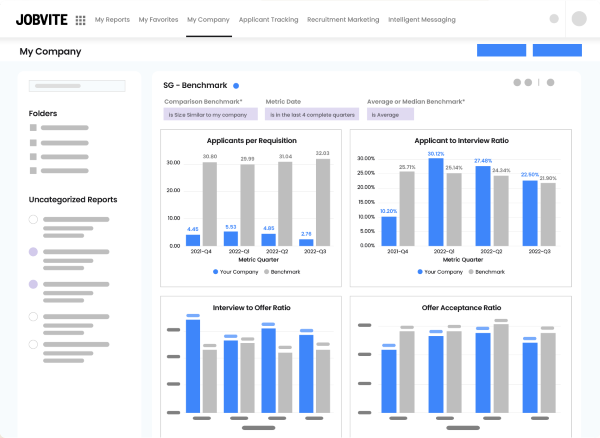
Key Features of Jobvite Reporting and Analytics:
- Comprehensive Recruitment Metrics: Jobvite offers a wide array of pre-built reports covering all aspects of the recruitment process, from sourcing effectiveness to offer acceptance rates.
- Advanced Custom Reporting: The platform provides powerful custom reporting tools that allow users to dig deep into their recruitment data. Users can create complex queries and reports to address specific analytical needs.
- Predictive Analytics: Jobvite incorporates predictive analytics features that use historical data to forecast future recruitment trends and outcomes.
- Interactive Visualizations: The system offers interactive data visualizations that allow users to explore recruitment data dynamically, uncovering insights and patterns.
- Automated Report Distribution: Jobvite enables users to schedule and automate the distribution of key reports to stakeholders, ensuring that decision-makers always have access to the latest recruitment data.
Jobvite’s reporting and analytics capabilities are designed to provide deep, data-driven insights that can inform strategic recruitment decisions.
Comparison and Conclusion
When comparing Greenhouse vs Jobvite in terms of reporting and analytics, both platforms offer robust features, but with different strengths that may appeal to different organizational needs.
Greenhouse stands out for its user-friendly approach to reporting and analytics. Its pre-built reports, customizable dashboards, and focus on diversity metrics make it particularly effective for organizations that want to quickly gain actionable insights from their recruitment data. The platform’s benchmark reporting feature is also valuable for companies looking to measure their performance against industry standards.
Jobvite, on the other hand, excels in its advanced analytical capabilities. Its powerful custom reporting tools, predictive analytics, and interactive visualizations make it a strong choice for organizations that require deep, complex analysis of their recruitment data. The automated report distribution feature is particularly useful for large organizations with multiple stakeholders.
In summary:
- Greenhouse is ideal for:
- Organizations that value user-friendly, actionable reporting
- Companies focused on improving diversity and inclusion in their hiring
- Teams that need quick access to key recruitment metrics and benchmarks
- Jobvite is well-suited for:
- Organizations that require advanced, in-depth data analysis
- Companies looking to leverage predictive analytics in their recruitment strategy
- Teams that need to distribute complex reports to multiple stakeholders regularly
When choosing between Greenhouse vs Jobvite for reporting and analytics, consider your organization’s specific needs, such as the level of analytical complexity required, the importance of user-friendly interfaces, and the extent to which you plan to use data in strategic decision-making. Both platforms offer comprehensive reporting and analytics features, but their different approaches may align better with different organizational priorities and data analysis capabilities.
Ultimately, the right choice will depend on how well the platform’s reporting and analytics capabilities align with your organization’s data strategy and decision-making processes. By carefully evaluating these factors, you can select the ATS that will best support your efforts to leverage data for more effective, efficient, and strategic recruitment.
Compliance and Data Security
When comparing Greenhouse vs Jobvite, compliance and data security are critical factors to consider. Both platforms prioritize these aspects, but they approach them in slightly different ways.
Greenhouse Compliance and Data Security
Greenhouse places a strong emphasis on compliance and data security, offering robust features to protect sensitive information and meet regulatory requirements.
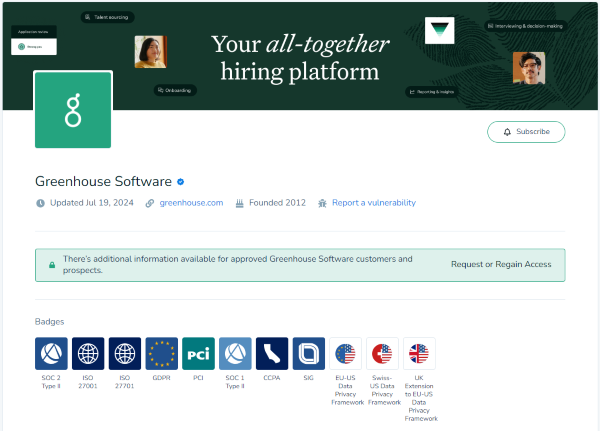
Key Features of Greenhouse Compliance and Data Security:
- GDPR Compliance: Greenhouse is fully GDPR compliant and provides tools to help customers meet their GDPR obligations. This includes features for data subject access requests, data portability, and the right to be forgotten[1].
- CCPA/CPRA Compliance: The platform also supports compliance with the California Consumer Privacy Act (CCPA) and California Privacy Rights Act (CPRA), offering necessary data protection and privacy controls[1].
- Data Encryption: Greenhouse employs encryption both in transit and at rest, ensuring that sensitive data is protected at all times[1].
- ISO Certifications: The company holds ISO 27001:2013 and ISO 27701:2019 certifications, demonstrating its commitment to information security management[1].
- SOC Compliance: Greenhouse undergoes annual SOC 1 Type 2 and SOC 2 Type 2 audits, verifying the effectiveness of its security controls[1].
- Regular Security Audits: The platform undergoes annual third-party penetration testing and maintains a bug bounty program to continuously improve security[1].
Greenhouse’s approach to compliance and data security focuses on providing a comprehensive set of tools and certifications to ensure data protection and regulatory compliance.
Jobvite Compliance and Data Security
Jobvite also prioritizes compliance and data security, offering features designed to protect data and meet regulatory requirements.
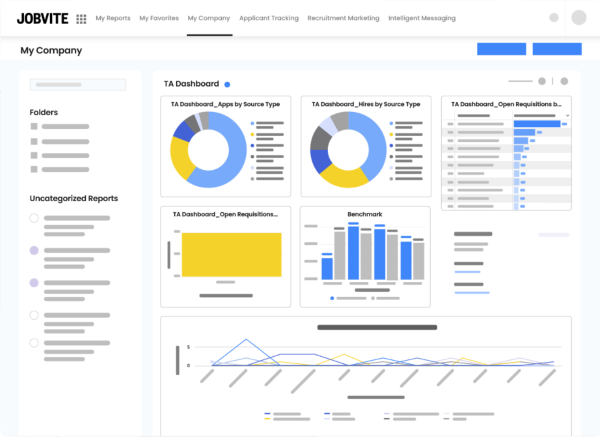
Key Features of Jobvite Compliance and Data Security:
- Data Protection Regulations: Jobvite supports compliance with various data protection regulations, including GDPR and CCPA.
- Data Encryption: The platform uses encryption to protect data both in transit and at rest.
- Access Controls: Jobvite provides robust user access controls, allowing organizations to manage who can access sensitive data.
- Regular Security Audits: The company conducts regular security audits and assessments to ensure the integrity of its security measures.
- Privacy by Design: Jobvite incorporates privacy considerations into its product development process, ensuring that privacy is built into its features from the ground up.
Jobvite’s approach to compliance and data security focuses on providing the necessary tools and features to help organizations protect their data and meet regulatory requirements.
Comparison and Conclusion
When comparing Greenhouse vs Jobvite in terms of compliance and data security, both platforms offer strong features, but with some differences in their approach and certifications.
Greenhouse stands out with its extensive list of certifications, including ISO 27001:2013, ISO 27701:2019, and SOC 1 and 2 compliance. These certifications provide third-party validation of Greenhouse’s security practices, which can be particularly important for organizations in highly regulated industries. Greenhouse’s detailed approach to GDPR and CCPA/CPRA compliance is also noteworthy.
Jobvite, while also offering robust security features, may not have the same level of publicly available information about specific certifications. However, its focus on privacy by design and regular security audits demonstrates a strong commitment to data protection and compliance.
In summary:
- Greenhouse is ideal for:
- Organizations that require vendors with specific security certifications
- Companies operating in highly regulated industries
- Businesses with stringent GDPR or CCPA/CPRA compliance needs
- Jobvite is well-suited for:
- Organizations looking for strong, built-in data protection features
- Companies that value privacy by design in their software solutions
- Businesses requiring flexible access controls for data security
When choosing between Greenhouse vs Jobvite for compliance and data security, consider your organization’s specific regulatory requirements, the importance of third-party security certifications, and the level of control you need over data access and protection. Both platforms offer strong compliance and security features, but their different approaches may align better with different organizational priorities and regulatory environments.
Ultimately, the right choice will depend on how well the platform’s compliance and data security capabilities align with your organization’s specific needs and risk management strategy. By carefully evaluating these factors, you can select the ATS that will best support your efforts to maintain compliance and protect sensitive data throughout the recruitment process.
Integration and Compatibility
When comparing Greenhouse vs Jobvite, integration and compatibility capabilities are crucial factors to consider. Both platforms offer a range of integrations to enhance their functionality and seamlessly connect with other HR and business tools.
Greenhouse Integration and Compatibility
Greenhouse provides a robust ecosystem of integrations, allowing it to work seamlessly with a wide variety of HR and business applications.
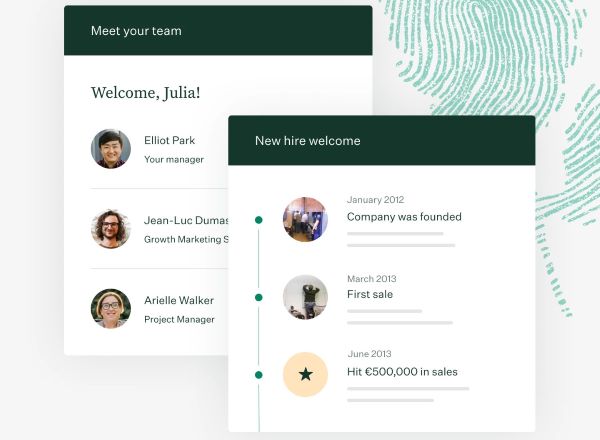
Key Features of Greenhouse Integration and Compatibility:
- HRIS/HCM System Integration: Greenhouse offers native integrations with popular HRIS and HCM systems such as Workday, BambooHR, and ADP. These integrations enable smooth data flow between recruitment and core HR processes.
- Third-Party Tool Integrations: The platform supports a wide range of third-party integrations for background checks, assessments, video interviewing, and more. Notable partners include HireRight, Checkr, HackerRank, and Zoom.
- API Access: Greenhouse provides a comprehensive API that allows for custom integrations and data synchronization with other systems.
- Single Sign-On (SSO): The platform supports SSO, allowing users to access Greenhouse using their existing corporate credentials.
- Zapier Integration: Greenhouse’s integration with Zapier enables connections with thousands of other applications, expanding its compatibility even further.
Greenhouse’s approach to integration and compatibility focuses on providing a wide range of pre-built integrations while also offering flexibility for custom solutions through its API.
Jobvite Integration and Compatibility
Jobvite also offers a comprehensive set of integrations, designed to enhance its functionality and connect with various HR and business tools.
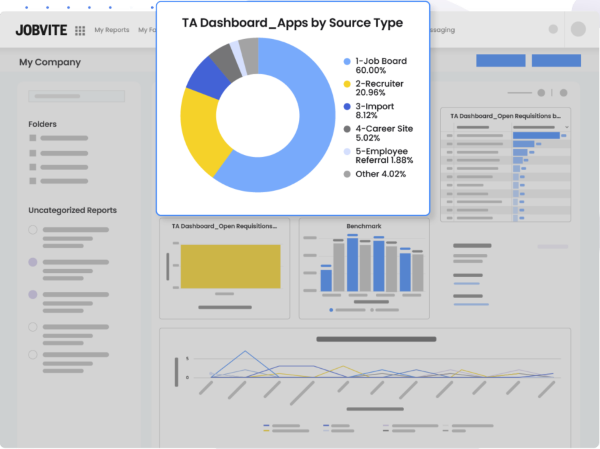
Key Features of Jobvite Integration and Compatibility:
- HRIS/HCM Integrations: Jobvite integrates with major HRIS and HCM systems, including Workday, UltiPro, and ADP, ensuring smooth data transfer between recruitment and core HR functions.
- Third-Party Tool Integrations: The platform supports integrations with numerous third-party tools for background screening, assessments, and onboarding. Partners include Sterling, Criteria Corp, and DocuSign.
- Open API: Jobvite provides an open API that allows for custom integrations and data synchronization with other systems.
- Single Sign-On (SSO): The system supports SSO, enabling users to access Jobvite using their existing corporate credentials.
- Chrome Extension: Jobvite offers a Chrome extension that allows users to easily add candidates from various websites and social media platforms.
Jobvite’s integration and compatibility strategy focuses on providing a mix of pre-built integrations and tools for custom solutions, catering to a wide range of organizational needs.
Comparison and Conclusion
When comparing Greenhouse vs Jobvite in terms of integration and compatibility, both platforms offer strong capabilities, but with some differences in their approach and partner ecosystems.
Greenhouse stands out with its extensive list of pre-built integrations, particularly in the areas of assessment tools and background check providers. Its integration with Zapier also significantly expands its compatibility with other business tools. The platform’s well-documented API and developer resources make it a strong choice for organizations with complex integration needs.
Jobvite, while also offering a robust set of integrations, particularly excels in its Chrome extension for sourcing candidates from various online platforms. Its open API provides flexibility for custom integrations, and its partnerships with major HRIS providers ensure smooth data flow between recruitment and core HR functions.
In summary:
- Greenhouse is ideal for:
- Organizations that require a wide range of pre-built integrations
- Companies looking for extensive assessment and background check integrations
- Businesses that value the flexibility of connecting with thousands of apps through Zapier
- Jobvite is well-suited for:
- Organizations that prioritize social recruiting and need tools like the Chrome extension
- Companies looking for strong HRIS integrations
- Businesses that require an open API for custom integrations
When choosing between Greenhouse vs Jobvite for integration and compatibility, consider your organization’s existing tech stack, the specific third-party tools you use in your recruitment process, and your need for custom integrations. Both platforms offer comprehensive integration capabilities, but their different approaches and partner ecosystems may align better with different organizational needs.
Ultimately, the right choice will depend on how well the platform’s integration and compatibility features align with your current and future technology requirements. By carefully evaluating these factors, you can select the ATS that will best integrate with your existing systems and support your overall recruitment and HR technology strategy.
Customization and Scalability
When comparing Greenhouse vs Jobvite, customization and scalability are crucial factors that can significantly impact an organization’s ability to tailor the ATS to their specific needs and grow with the platform over time.
Greenhouse Customization and Scalability
Greenhouse offers a high degree of customization and is designed to scale with growing organizations.
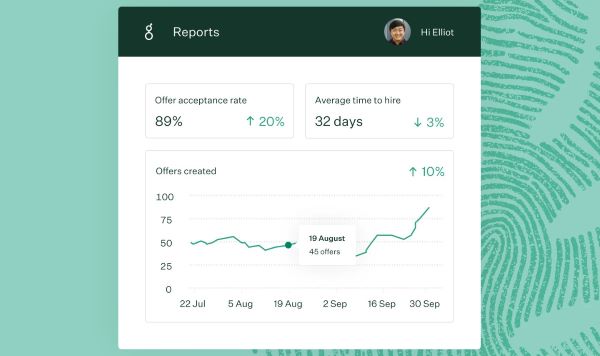
Key Features of Greenhouse Customization and Scalability:
- Workflow Customization: Greenhouse allows users to create custom hiring workflows tailored to different roles, departments, or locations. This flexibility enables organizations to adapt the platform to their unique recruitment processes.
- Custom Fields: The system supports the creation of custom fields throughout the application, allowing organizations to capture and track specific data points relevant to their hiring needs.
- Configurable Permissions: Greenhouse offers granular permission settings, enabling organizations to control access to sensitive information and tailor user roles to their organizational structure.
- Scalable Architecture: The platform is built on a scalable infrastructure that can handle high volumes of job postings, applications, and users, making it suitable for both small businesses and large enterprises.
- Multi-Language Support: Greenhouse supports multiple languages, allowing global organizations to use the platform across different regions.
Greenhouse’s approach to customization and scalability focuses on providing flexible tools that can be adapted to various organizational needs while ensuring the platform can grow with its customers.
Jobvite Customization and Scalability
Jobvite also offers strong customization options and is designed to scale with organizations of various sizes.
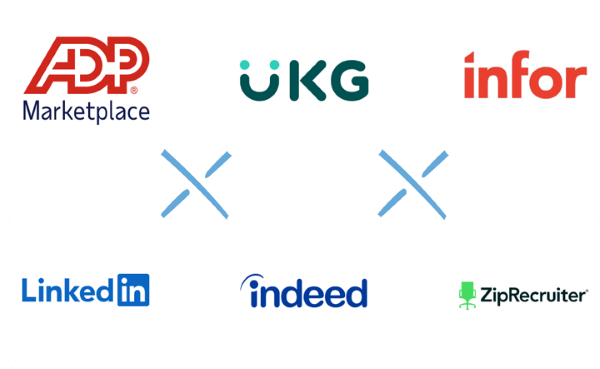
Key Features of Jobvite Customization and Scalability:
- Customizable Workflows: Jobvite allows users to create and modify recruitment workflows to match their specific hiring processes. This includes the ability to customize stages, tasks, and approval processes.
- Configurable Forms and Fields: The platform supports the creation of custom application forms and fields, enabling organizations to collect the specific information they need from candidates.
- Branding Customization: Jobvite offers extensive branding options, allowing organizations to customize their career sites and application processes to match their corporate identity.
- Scalable Platform: Jobvite’s architecture is designed to handle high-volume hiring, making it suitable for organizations of all sizes, from small businesses to large enterprises.
- Global Capabilities: The platform supports multiple languages and currencies, facilitating its use in global recruitment efforts.
Jobvite’s customization and scalability features are designed to provide flexibility while supporting organizations as they grow and their recruitment needs evolve.
Comparison and Conclusion
When comparing Greenhouse vs Jobvite in terms of customization and scalability, both platforms offer strong capabilities, but with some differences in their approach and strengths.
Greenhouse stands out with its highly flexible workflow customization options and granular permission settings. These features make it particularly well-suited for organizations with complex hiring processes or those that require precise control over user access. Greenhouse’s scalability and multi-language support also make it a strong contender for growing, global organizations.
Jobvite excels in its branding customization options, allowing organizations to create a highly tailored candidate experience. Its configurable forms and fields provide flexibility in data collection, and its scalable architecture ensures it can handle high-volume hiring needs. Jobvite’s global capabilities also make it suitable for international recruitment efforts.
In summary:
- Greenhouse is ideal for:
- Organizations with complex, varied hiring processes requiring extensive workflow customization
- Companies that need granular control over user permissions and access
- Businesses looking for a highly scalable platform with strong multi-language support
- Jobvite is well-suited for:
- Organizations that prioritize creating a branded, customized candidate experience
- Companies looking for flexibility in customizing application forms and data collection
- Businesses requiring a scalable platform with strong global recruitment capabilities
When choosing between Greenhouse vs Jobvite for customization and scalability, consider your organization’s specific needs in terms of process flexibility, branding requirements, and growth projections. Both platforms offer comprehensive customization and scalability features, but their different strengths may align better with different organizational priorities.
Ultimately, the right choice will depend on how well the platform’s customization and scalability capabilities align with your current processes and future growth plans. By carefully evaluating these factors, you can select the ATS that will best adapt to your unique recruitment needs and support your organization’s growth over time.
AI and Automation Features
When comparing Greenhouse vs Jobvite, their AI and automation capabilities are crucial factors to consider. Both platforms leverage artificial intelligence and automation to streamline recruitment processes, but they approach these technologies in distinct ways.
Greenhouse AI and Automation Features
Greenhouse has been steadily incorporating AI and automation features to enhance its recruitment capabilities.
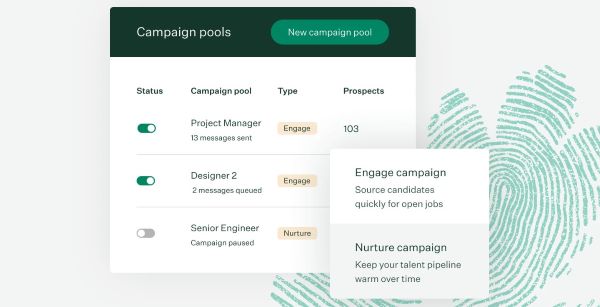
Key Features of Greenhouse AI and Automation:
- AI-Powered Candidate Matching: Greenhouse uses AI algorithms to analyze job requirements and candidate profiles, providing recruiters with a ranked list of the most suitable candidates for each position.
- Automated Screening and Scheduling: The platform offers automated initial screening of candidates based on predefined criteria, and can automatically schedule interviews with qualified candidates, reducing manual work for recruiters.
- Intelligent Resume Parsing: Greenhouse’s AI-driven resume parsing technology extracts relevant information from resumes and populates candidate profiles, saving time and ensuring consistency in data entry.
- Predictive Analytics: The system uses machine learning to provide insights on hiring trends, time-to-fill predictions, and candidate success likelihood, helping organizations make data-driven decisions.
- Automated Communication: Greenhouse automates various communication touchpoints with candidates, including application confirmations, interview reminders, and status updates.
Greenhouse’s approach to AI and automation focuses on enhancing efficiency while maintaining a human-centric recruitment process.
Jobvite AI and Automation Features
Jobvite has made significant investments in AI and automation technologies to provide advanced recruitment solutions.

Key Features of Jobvite AI and Automation:
- AI-Powered Candidate Matching: Jobvite’s AI algorithms analyze job requirements and candidate profiles to provide recruiters with a ranked list of the most suitable candidates, similar to Greenhouse.
- Automated Sourcing: The platform uses AI to actively search various online platforms and databases to identify potential candidates who match job requirements, even if they haven’t applied.
- Intelligent Screening: Jobvite’s AI-driven screening tools can evaluate candidates based on multiple criteria, including skills, experience, and cultural fit.
- Chatbots and Conversational AI: Jobvite offers AI-powered chatbots that can engage with candidates, answer common questions, and even conduct initial screenings.
- Predictive Analytics: The system provides predictive insights on candidate success, time-to-hire, and other key recruitment metrics.
Jobvite’s AI and automation features are designed to provide a high degree of automation throughout the recruitment process, from sourcing to screening and beyond.
Comparison and Conclusion
When comparing Greenhouse vs Jobvite in terms of AI and automation features, both platforms offer strong capabilities, but with some differences in their focus and implementation.
Greenhouse’s AI and automation features tend to focus on enhancing existing recruitment processes, with a strong emphasis on candidate matching, automated screening, and predictive analytics. Their approach seems to prioritize supporting recruiters in making better decisions rather than fully automating the process.
Jobvite, on the other hand, appears to take a more comprehensive approach to AI and automation, with features that span the entire recruitment lifecycle. Their automated sourcing capabilities and use of conversational AI for candidate engagement stand out as particularly advanced features.
In summary:
- Greenhouse is ideal for:
- Organizations looking for AI support in candidate matching and screening
- Companies that want to leverage predictive analytics in their hiring decisions
- Teams that prefer a balance between automation and human touch in recruitment
- Jobvite is well-suited for:
- Organizations seeking comprehensive AI-driven automation across the recruitment process
- Companies looking to leverage AI for proactive candidate sourcing
- Teams that want to implement conversational AI for candidate engagement
When choosing between Greenhouse vs Jobvite for AI and automation features, consider your organization’s specific needs in terms of process automation, the level of AI-driven decision support you require, and how much you want to leverage AI in candidate engagement. Both platforms offer robust AI and automation capabilities, but their different approaches may align better with different organizational priorities and recruitment strategies.
Ultimately, the right choice will depend on how well the platform’s AI and automation features align with your recruitment goals and your team’s comfort level with AI-driven processes. By carefully evaluating these factors, you can select the ATS that will best support your efforts to leverage AI and automation for more efficient, effective, and data-driven recruitment.
Candidate Experience
When comparing Greenhouse vs Jobvite, the candidate experience is a crucial factor that can significantly impact an organization’s ability to attract and retain top talent. Both platforms offer features designed to enhance the candidate journey, but they approach this aspect in slightly different ways.
Greenhouse Candidate Experience
Greenhouse places a strong emphasis on creating a positive and engaging candidate experience throughout the recruitment process.
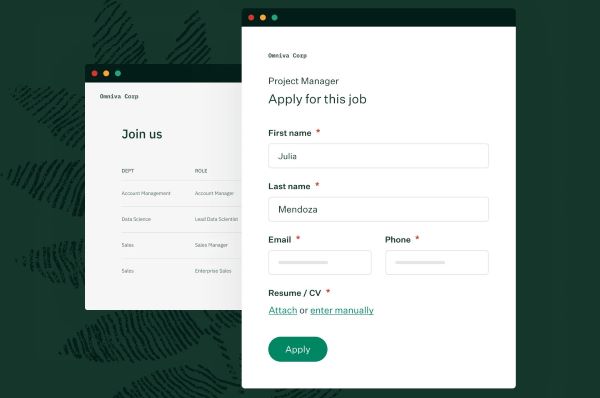
Key Features of Greenhouse Candidate Experience:
- Application Process Simplicity: Greenhouse offers a streamlined, mobile-friendly application process that allows candidates to easily submit their applications, often with the option to apply using their LinkedIn profiles or upload resumes from cloud storage services.
- Branded Career Pages: The platform enables organizations to create customized, branded career pages that reflect their company culture and values, providing candidates with a cohesive experience from the start.
- Candidate Self-Scheduling: Greenhouse allows candidates to self-schedule their interviews, reducing back-and-forth communication and giving candidates more control over the process.
- Automated Communication: The system provides automated, personalized communication touchpoints throughout the hiring process, keeping candidates informed about their application status.
- Feedback Mechanism: Greenhouse includes features for collecting candidate feedback about the recruitment process, allowing organizations to continuously improve their candidate experience.
Greenhouse’s approach to candidate experience focuses on simplicity, transparency, and consistent communication throughout the recruitment journey.
Jobvite Candidate Experience
Jobvite also prioritizes the candidate experience, offering a range of features designed to engage and inform candidates throughout the hiring process.
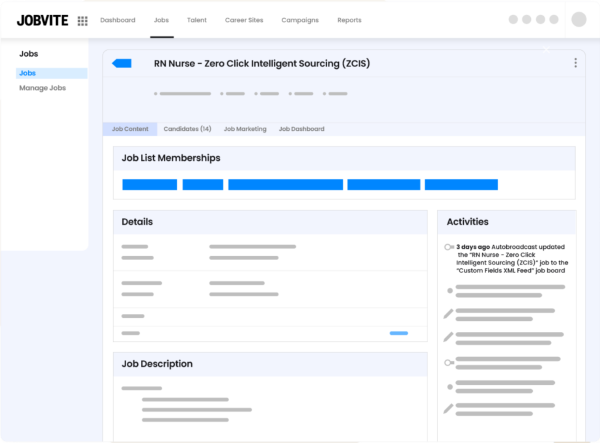
Key Features of Jobvite Candidate Experience:
- Mobile-Optimized Application Process: Jobvite provides a mobile-friendly application process, allowing candidates to easily apply for positions from any device.
- AI-Powered Job Recommendations: The platform uses AI to suggest relevant job openings to candidates based on their profiles and preferences, enhancing their job search experience.
- Candidate Relationship Management (CRM): Jobvite’s CRM features allow organizations to nurture relationships with candidates over time, providing a more personalized experience.
- Text Recruiting: The platform offers text recruiting capabilities, allowing for quick and convenient communication with candidates via their preferred method.
- Candidate Portal: Jobvite provides a candidate portal where applicants can check their application status, schedule interviews, and receive updates about the hiring process.
Jobvite’s candidate experience features focus on personalization, convenience, and ongoing engagement with potential hires.
Comparison and Conclusion
When comparing Greenhouse vs Jobvite in terms of candidate experience, both platforms offer strong features, but with some differences in their approach and focus.
Greenhouse stands out with its emphasis on simplicity and transparency in the application process. Its self-scheduling feature and automated communication touchpoints are particularly noteworthy for keeping candidates informed and engaged. The platform’s focus on collecting candidate feedback also demonstrates a commitment to continuous improvement of the candidate experience.
Jobvite excels in its use of AI for job recommendations and its strong CRM capabilities. The platform’s text recruiting feature is a standout, catering to candidates who prefer more immediate and informal communication methods. Jobvite’s candidate portal also provides a comprehensive tool for candidates to manage their application process.
In summary:
- Greenhouse is ideal for:
- Organizations prioritizing a streamlined, transparent application process
- Companies looking to offer candidates more control through self-scheduling
- Businesses committed to continuously improving their candidate experience through feedback
- Jobvite is well-suited for:
- Organizations wanting to leverage AI for personalized job recommendations
- Companies looking to build long-term relationships with candidates through CRM features
- Businesses seeking to engage candidates through multiple communication channels, including text
When choosing between Greenhouse vs Jobvite for candidate experience, consider your organization’s specific needs in terms of application process simplicity, communication preferences, and long-term candidate engagement strategies. Both platforms offer comprehensive features to enhance the candidate experience, but their different approaches may align better with different organizational priorities and candidate demographics.
Ultimately, the right choice will depend on how well the platform’s candidate experience features align with your employer branding strategy and the expectations of your target candidate pool. By carefully evaluating these factors, you can select the ATS that will best support your efforts to create a positive, engaging candidate experience that attracts top talent and strengthens your employer brand.
Customer Support and Service
When comparing Greenhouse vs Jobvite, the quality of customer support and service can significantly impact user satisfaction and the overall value derived from the platform. Both companies offer various support options, but they differ in their approach and the resources they provide.
Greenhouse Customer Support and Service
Greenhouse is known for its comprehensive customer support and service offerings, designed to ensure users can maximize the platform’s potential.
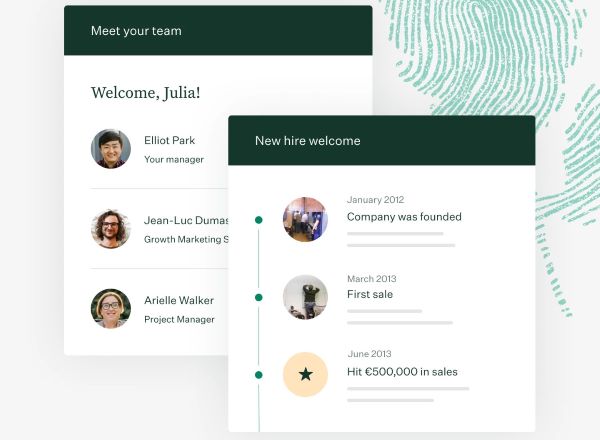
Key Features of Greenhouse Customer Support and Service:
- Training and Onboarding Support: Greenhouse provides extensive onboarding support, including personalized training sessions and a structured implementation process to ensure smooth adoption of the platform.
- Dedicated Customer Success Manager: Depending on the plan, customers may be assigned a dedicated Customer Success Manager who provides ongoing support and strategic guidance.
- 24/7 Technical Support: Greenhouse offers round-the-clock technical support through various channels, including phone, email, and live chat.
- Knowledge Base and Documentation: The platform provides a comprehensive knowledge base with detailed documentation, how-to guides, and best practices.
- Community Forum: Greenhouse maintains an active user community forum where customers can share insights, ask questions, and learn from peers.
- Regular Webinars and Training Sessions: The company offers ongoing webinars and training sessions to help users stay updated on new features and best practices.
Greenhouse’s approach to customer support emphasizes proactive assistance and continuous education to ensure users can fully leverage the platform’s capabilities.
Jobvite Customer Support and Service
Jobvite also offers robust customer support and service options, focusing on providing resources and assistance to help customers succeed.

Key Features of Jobvite Customer Support and Service:
- Implementation Support: Jobvite provides implementation support to help customers set up and configure the platform according to their specific needs.
- Customer Success Team: Depending on the plan, customers may have access to a Customer Success team that offers strategic guidance and support.
- Technical Support: Jobvite offers technical support through various channels, including email and phone, during business hours.
- Online Resource Center: The platform provides an extensive online resource center with user guides, FAQs, and best practice documents.
- Training Programs: Jobvite offers both online and in-person training programs to help users become proficient with the platform.
- Product Updates and Release Notes: Regular product updates are communicated through release notes, keeping customers informed about new features and improvements.
Jobvite’s customer support and service focus on providing the necessary resources and assistance to help customers effectively use and derive value from the platform.
Comparison and Conclusion
When comparing Greenhouse vs Jobvite in terms of customer support and service, both platforms offer strong options, but with some differences in their approach and availability.
Greenhouse stands out with its 24/7 technical support and dedicated Customer Success Managers for certain plans. The company’s extensive knowledge base, active community forum, and regular webinars demonstrate a strong commitment to ongoing customer education and support.
Jobvite, while not offering 24/7 support, provides comprehensive implementation assistance and a robust online resource center. Their training programs and product update communications show a focus on ensuring customers can effectively use the platform and stay informed about new features.
In summary:
- Greenhouse is ideal for:
- Organizations that require round-the-clock technical support
- Companies looking for extensive onboarding and ongoing training resources
- Businesses that value access to a user community for peer learning and support
- Jobvite is well-suited for:
- Organizations that prioritize strong implementation support
- Companies that prefer self-service resources and documentation
- Businesses looking for regular product updates and communication
When choosing between Greenhouse vs Jobvite for customer support and service, consider your organization’s specific needs in terms of support availability, preferred learning methods, and the level of ongoing assistance required. Both platforms offer comprehensive support options, but their different approaches may align better with different organizational preferences and support requirements.
Ultimately, the right choice will depend on how well the platform’s customer support and service offerings align with your team’s needs and your organization’s capacity for self-service versus hands-on support. By carefully evaluating these factors, you can select the ATS that will provide the level of support necessary to ensure successful implementation, adoption, and ongoing use of the platform within your organization.
Pricing and Cost-effectiveness
When comparing Greenhouse vs Jobvite, pricing and cost-effectiveness are crucial factors that can significantly impact an organization’s decision. Both platforms offer various pricing models, but they differ in their approach and the value they provide for different types of organizations.

Greenhouse Pricing and Cost-effectiveness
Greenhouse offers a tiered pricing structure based on organization size and needs.
Key Features of Greenhouse Pricing:
- Pricing Models: Greenhouse typically offers three main plans: Basic, Pro, and Enterprise. Pricing is usually based on the number of employees in the organization.
- Per-Employee Pricing: The platform generally charges on a per-employee basis, which can be beneficial for smaller organizations but may become more expensive as the company grows.
- Custom Enterprise Pricing: For larger organizations or those with complex needs, Greenhouse offers custom Enterprise pricing with additional features and support.
- Add-On Features: Some advanced features may be available as add-ons for an additional cost.
- ROI Considerations: Greenhouse emphasizes the potential for improved hiring efficiency and quality, which can lead to long-term cost savings despite potentially higher upfront costs.
Greenhouse’s pricing model is designed to scale with organizations, offering more features and support as the price increases.
For more information about pricing, please visit Greenhouse’s website.
Jobvite Pricing and Cost-effectiveness
Jobvite also offers a tiered pricing structure, with options for organizations of different sizes and needs.
Key Features of Jobvite Pricing:
- Pricing Tiers: Jobvite typically offers several tiers, including Basic, Pro, and Enterprise options, with pricing based on the organization’s specific needs.
- Per-Recruiter Pricing: Unlike Greenhouse, Jobvite often bases its pricing on the number of recruiters or active users rather than total employees, which can be more cost-effective for larger organizations with smaller recruiting teams.
- Modular Approach: Jobvite allows organizations to select and pay for only the modules they need, potentially reducing costs for companies that don’t require the full suite of features.
- Annual Contracts: Jobvite generally requires annual contracts, which can provide pricing stability but may be less flexible for organizations with fluctuating needs.
- ROI Focus: Jobvite emphasizes the potential for improved recruitment efficiency and reduced time-to-hire as key factors in its cost-effectiveness.
Jobvite’s pricing model is designed to be flexible, allowing organizations to choose the features they need while potentially controlling costs.
For more information about pricing, please visit Jobvite’s website.
Comparison and Conclusion
When comparing Greenhouse vs Jobvite in terms of pricing and cost-effectiveness, both platforms offer tiered pricing structures, but with some key differences in their approach.
Greenhouse’s per-employee pricing model can be advantageous for smaller organizations or those expecting significant growth, as it allows access to a full feature set. However, it may become more expensive for larger organizations. The platform’s emphasis on improved hiring quality and efficiency can justify the cost for organizations prioritizing these aspects.
Jobvite’s per-recruiter pricing and modular approach can be more cost-effective for larger organizations with focused recruiting teams or those that only need specific features. This model allows for more control over costs but may require careful consideration of which features are essential.
In summary:
- Greenhouse may be more cost-effective for:
- Smaller organizations or startups expecting rapid growth
- Companies that want access to a full feature set from the beginning
- Organizations prioritizing hiring quality and willing to invest in comprehensive tools
- Jobvite may be more cost-effective for:
- Larger organizations with focused recruiting teams
- Companies that need specific features rather than a full suite
- Organizations looking for more control over their ATS costs
When choosing between Greenhouse vs Jobvite for pricing and cost-effectiveness, consider your organization’s size, growth projections, specific feature needs, and long-term recruitment strategy. It’s crucial to look beyond the initial price and consider the potential return on investment in terms of improved hiring efficiency, quality of hires, and time saved.
Ultimately, the most cost-effective choice will depend on how well the platform’s pricing model aligns with your organization’s structure, recruitment needs, and budget. Be sure to request detailed quotes from both providers, including any potential add-on costs, to make an accurate comparison. Consider also the potential for improved recruitment outcomes and efficiency gains when evaluating the overall cost-effectiveness of each platform.
User Reviews and Testimonials
When comparing Greenhouse vs Jobvite, user reviews and testimonials provide valuable insights into real-world experiences with these platforms. Both Applicant Tracking Systems (ATS) have garnered feedback from recruiters, HR professionals, and candidates, offering a comprehensive view of their strengths and potential areas for improvement.
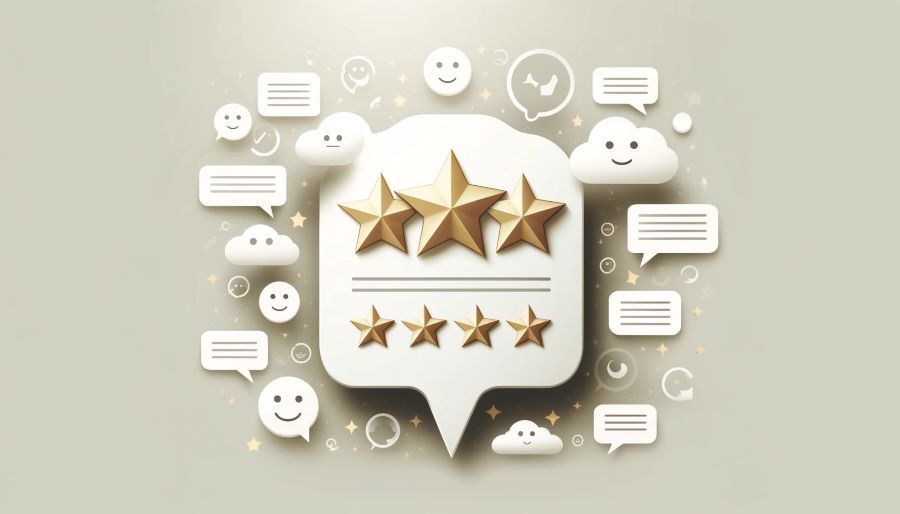
Greenhouse User Reviews and Testimonials
Greenhouse has generally received positive feedback from its users across various review platforms.
Key Points from Greenhouse Reviews:
- User Interface: Many users praise Greenhouse for its intuitive and user-friendly interface. Recruiters often mention how easy it is to navigate the platform and manage the hiring process.
- Customization: Users appreciate the high level of customization Greenhouse offers, allowing them to tailor the platform to their specific recruitment processes.
- Candidate Experience: Several reviews highlight the positive candidate experience Greenhouse facilitates, particularly noting the smooth application process and effective communication tools.
- Reporting: Many users commend Greenhouse’s robust reporting capabilities, which help them track key metrics and make data-driven decisions.
- Integration: The platform’s wide range of integrations with other HR tools is frequently mentioned as a significant advantage.
- Areas for Improvement: Some users note that the platform can be overwhelming for smaller organizations due to its extensive feature set. A few also mention that certain advanced features have a steeper learning curve.
Sample Testimonial: “Greenhouse has transformed our hiring process. Its intuitive interface and customizable workflows have significantly improved our efficiency. The reporting features provide invaluable insights into our recruitment metrics.” – HR Director at a mid-size tech company
Jobvite User Reviews and Testimonials
Jobvite also receives generally positive feedback from its users, with particular emphasis on certain features.
Key Points from Jobvite Reviews:
- Social Recruiting: Many users praise Jobvite’s social recruiting capabilities, noting how it simplifies the process of leveraging social networks for talent acquisition.
- Automation: Users frequently mention the platform’s automation features as a significant time-saver, particularly in areas like resume parsing and initial candidate screening.
- CRM Functionality: The Candidate Relationship Management features are often highlighted as a strength, allowing for better long-term engagement with potential candidates.
- Mobile App: Several reviews commend Jobvite’s mobile app, which allows recruiters to manage tasks on-the-go.
- Customization: Users appreciate the ability to customize various aspects of the platform, though some note it can be complex.
- Areas for Improvement: Some users mention that the user interface could be more intuitive and that the initial setup process can be time-consuming.
Sample Testimonial: “Jobvite has significantly enhanced our recruitment efforts, especially in terms of social recruiting and candidate relationship management. The automation features have freed up our recruiters to focus on more strategic tasks.” – Talent Acquisition Manager at a large retail company
Comparison and Conclusion
When comparing Greenhouse vs Jobvite based on user reviews and testimonials, both platforms receive positive feedback overall, but with different strengths highlighted.
Greenhouse is often praised for its user-friendly interface, extensive customization options, and strong reporting capabilities. Users frequently mention the positive impact on both recruiter efficiency and candidate experience.
Jobvite receives high marks for its social recruiting tools, automation features, and CRM functionality. Users often highlight how these features help them engage with candidates more effectively and streamline their recruitment processes.
In summary:
- Greenhouse is often preferred by users who:
- Value an intuitive, user-friendly interface
- Require extensive customization options
- Prioritize strong reporting and analytics capabilities
- Jobvite is frequently favored by users who:
- Focus heavily on social recruiting
- Require robust automation features
- Prioritize long-term candidate relationship management
When choosing between Greenhouse vs Jobvite, these user reviews and testimonials can provide valuable insights into how each platform performs in real-world scenarios. However, it’s important to remember that individual experiences can vary based on factors such as organization size, industry, and specific use cases.
To make the most informed decision, consider reaching out to peers in your industry who use these platforms, or request case studies from Greenhouse and Jobvite that align with your organization’s size and recruitment needs. Additionally, taking advantage of free trials or demos can give you firsthand experience with each platform’s strengths and potential limitations.
Conclusion
After an extensive comparison of Greenhouse vs Jobvite across various crucial aspects of applicant tracking systems, it’s clear that both platforms offer robust solutions for modern recruitment needs. However, each has its unique strengths that may better suit different organizational requirements.
Overall Strengths and Weaknesses
Greenhouse stands out for its user-friendly interface, extensive customization options, and strong focus on creating a positive candidate experience. Its robust reporting and analytics capabilities, coupled with a wide range of integrations, make it a powerful tool for data-driven recruitment. However, some users find the extensive feature set overwhelming, particularly for smaller organizations.
Jobvite excels in social recruiting, automation features, and candidate relationship management. Its modular approach to pricing and per-recruiter model can be cost-effective for certain organizations. The platform’s emphasis on long-term talent nurturing and AI-powered features are particularly noteworthy. However, some users report a steeper learning curve and a more complex initial setup process.
Best-Fit Scenarios
Greenhouse is likely the better choice for:
- Organizations prioritizing user experience for both recruiters and candidates
- Companies requiring extensive customization and integration capabilities
- Businesses focusing on data-driven recruitment decisions and detailed analytics
- Growing companies that value scalability and comprehensive feature sets
Jobvite may be the preferred option for:
- Organizations with a strong focus on social recruiting and employer branding
- Companies looking for advanced automation and AI-powered features
- Businesses prioritizing long-term candidate relationship management
- Larger organizations that can benefit from the per-recruiter pricing model
Final Thoughts
Ultimately, the choice between Greenhouse vs Jobvite should be based on your organization’s specific recruitment needs, growth projections, and strategic priorities. Consider factors such as your team’s technical proficiency, the importance of specific features like social recruiting or analytics, and your budget constraints.
It’s recommended to take advantage of free trials or demos offered by both platforms to get a hands-on feel for their interfaces and functionalities. Additionally, consult with your IT department regarding integration capabilities and data security requirements.
Remember that implementing a new ATS is a significant undertaking that can impact your entire recruitment process. Whichever platform you choose, ensure that you have a solid implementation plan and adequate training resources to maximize your investment.
By carefully evaluating your needs against the strengths of each platform, you can select the ATS that will best support your organization’s recruitment goals, enhance your hiring processes, and ultimately contribute to building a strong, talented workforce.
![]()
![]() Read our full Greenhouse review.
Read our full Greenhouse review.
![]()
![]() Read our full Jobvite review.
Read our full Jobvite review.

